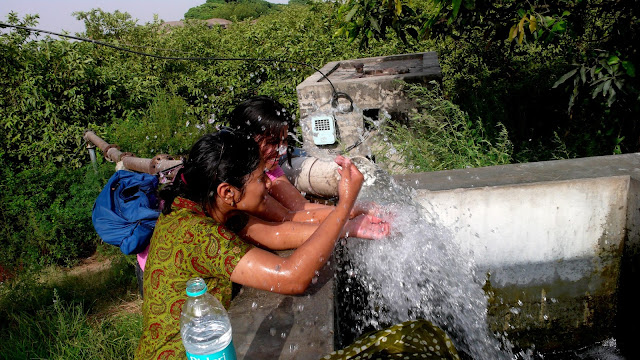Day 02
Date: 1st June, 2012,
Location: Sirhind, Talanian, Dera Mir Miran
Day two was dizzying. Priyaleen ma’am had joined us from Delhi,
and after we picked her up from the station we headed for the first stretch of
sites- Mahadiyan, Talanian, Fatehgarh Sahib- Sirhind and Dera Mir Miran.
And this was the longest stretch with more than a 100 structures
amongst these settlements. So we started.
Through the course of this day, there were three things that I
just had to write about.
- The Chabutras of Punjab’s
villages/ towns
- Chabeels distributing
water as respite
- The tombs scattered across
the fields of Sirhind.
Talanian ka Chabutra
– A vantage point
Location: Talanian
Settlement, District: Fatehgarh Sahib, Punjab
.JPG) |
| Photos by Author, Talanian ka Chabutra, Talanian, Punjab |
Wikipedia says the word Chabutra or
Chabutro is (also) sometimes used to
indicate a sitting platform, usually under a tree or beside any water-body like
lake, pond, etc. But commonly it is used to indicate the tower-like structure…
.JPG) |
| Photos by author |
This definition of a chabutra / chabutro (being a tower-like
structure) is what the rural landscape of Gujarat would substantiate, but in
Punjab a chabutra is quintessentially
a circular platform about a meter in height built under a large-size tree,
which usually bears a canopy of more than 10 m in diameter. This is a community
space that may also be used to address public gatherings of villagers like
Panchayat meetings (Bollywood style). The older folk of the village, mostly the
men-folk are seen gathering at these chabutras playing taash, drinking chai or
just chatting in the afternoons.
 |
| The menfolk seated at the Chabutra |
 The Chabutra of Talanian is ideal to peek into the function of a
chabutra in an Indian village. Talanian settlement now looks like a town mainly rural which in perhaps two or three decades (speculation) may head into urbanization. As one enters from the narrow lanes of the village shops
towards the Chabutra, the large space with a huge shade-giving tree in the
center may read as an ‘Incidental Nodal Space’ ( a term I learnt from a senior conservation colleague) within the rural
settlement.
The Chabutra of Talanian is ideal to peek into the function of a
chabutra in an Indian village. Talanian settlement now looks like a town mainly rural which in perhaps two or three decades (speculation) may head into urbanization. As one enters from the narrow lanes of the village shops
towards the Chabutra, the large space with a huge shade-giving tree in the
center may read as an ‘Incidental Nodal Space’ ( a term I learnt from a senior conservation colleague) within the rural
settlement.
But a closer look reads the space as more than just "incidental". From this locus various other loci can be charted. Like the village
Post Office, the Mosque of Talanian (wherein lies a sacred Sheesham tree), an
old colonnaded structure leading to the mosque- arguably a sample of colonial
architecture, and a dilapidated building made of nanakshahi bricks in the backdrop of the chabutra, next to the post
office.
Standing at this junction, one can just rotate at their station point
and see all these loci manifest the critical location of the village chabutra-
right at the centre of all the action. One could think on the lines of
proposals to use this existent space, or rather build a plan around it to
generate awareness and increase local knowledge of the history and the
historicity of the settlement wherein the chabutra could function as the
landmark / a vantage point.


.JPG)
.JPG)

.jpg)



.jpg)










.JPG)
.JPG)

.JPG)






.JPG)
.JPG)





